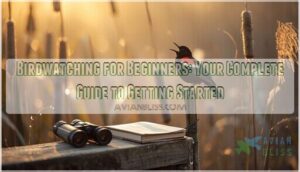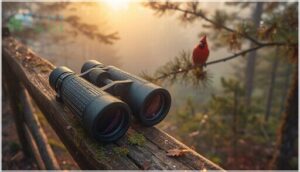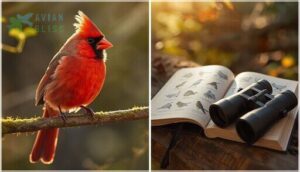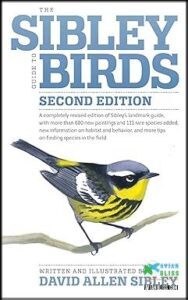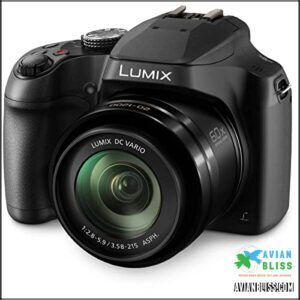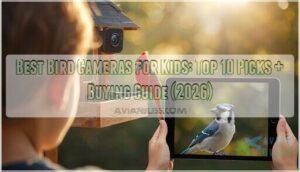This site is supported by our readers. We may earn a commission, at no cost to you, if you purchase through links.
A red-winged blackbird perched on a cattail, singing its raspy call, changed everything for me. I was just walking through a local wetland, frustrated and restless, when that flash of crimson caught my eye. That moment—standing still, watching, listening—felt like discovering a hidden dimension that existed right alongside my daily routine.
Birdwatching for beginners starts exactly like this: no fancy gear, no expert knowledge, just curiosity and a willingness to notice what’s already around you. The beauty of this hobby lies in its simplicity and accessibility—your backyard or neighborhood park holds more avian drama than you’d imagine.
Within weeks, you’ll start recognizing species by silhouette, hearing calls you never noticed before, and finding yourself surprisingly invested in whether those robins successfully raise their clutch.
Table Of Contents
- Key Takeaways
- Getting Started With Birdwatching
- Choosing The Best Birdwatching Locations
- Essential Birdwatching Equipment for Beginners
- Bird Identification Tips for New Birders
- Top Birdwatching Products for Beginners
- Frequently Asked Questions (FAQs)
- How to start birdwatching for beginners?
- How do I become a good birdwatcher?
- What equipment does a beginner birdwatcher need?
- How to start birdwatching outside the backyard?
- What is birdwatching 101?
- How to choose a bird watcher?
- How do you start birdwatching?
- What is the difference between birding and bird-watching?
- What time of year is best for birding?
- What are the best binoculars for bird-watching beginners?
- Conclusion
Key Takeaways
- Birdwatching requires almost nothing to start—just curiosity and attention to what’s already in your backyard or local park, making it one of the most accessible ways to connect with nature without permission or expensive gear.
- The practice delivers measurable mental and physical benefits that outperform general nature walks, including drops in anxiety and blood pressure, plus natural community connection through a network of over 100 million American participants.
- Successful identification comes down to training your eye for specific details like color patterns, wing markings, and beak variations, then layering in birdsong recognition to spot hidden species by ear before you ever see them.
- Your first essential purchases should be 8×42 binoculars for balanced zoom and stability, plus either a regional field guide like Sibley’s or a free app like Merlin Bird ID to turn mystery birds into confident identifications.
Getting Started With Birdwatching
Birdwatching isn’t some elite hobby reserved for experts with fancy gear—it’s one of the most accessible ways to break free from your routine and connect with the wild world around you. You don’t need permission, expensive equipment, or years of training to start.
Birdwatching is an accessible escape that requires no permission, expensive gear, or expertise to begin
Let’s cover what birdwatching actually is, why it’s worth your time, and how you can begin right now.
What is Birdwatching?
Birdwatching—or birding—is the practice of observing and identifying bird species in their natural habitats. You’re basically stepping into ornithology basics without the lab coat.
It’s a form of wildlife conservation through citizen science, where your observations of bird behavior and environmental impact matter. Unlike formal ornithology, bird watching is pure freedom: no protocols, just you connecting with nature on your terms.
By participating in bird conservation efforts, individuals can contribute to the understanding and protection of bird populations.
Benefits of Birdwatching for Beginners
Beyond simply identifying species, getting started with birding delivers real rewards that transform both mind and body. Here’s what you gain:
- Mental wellness improves dramatically—college students in birdwatching programs saw well-being scores rise more than nature walkers, with measurable drops in anxiety and depression.
- Stress relief happens fast—blood pressure and heart rate drop after field sessions, offering nature therapy that outperforms generic park visits.
- Physical health gets a gentle boost—low-impact walking increases vitamin D absorption and cardiovascular function without the injury risks of high-intensity exercise.
- Community connection grows naturally—over 100 million Americans participate in birding activities, creating instant social networks and mentorship opportunities.
Mindful observation of birds creates a unique form of stress reduction that general nature walks can’t match. Even short backyard sessions produce measurable mental resilience, making birding for beginners an accessible path to introduction to bird watching and lasting bird conservation awareness. Regular engagement in birdwatching walks can lead to significant improvements in overall health and wellbeing.
How to Begin Birdwatching
You already know the benefits—now it’s time to take that first step. Start in your own backyard or local park, where nearly 95% of birders get their first glimpses. Bring binoculars if you have them, but your eyes work fine at first.
Notice size, color, and movement. Download a free birding app like eBird to log what you see.
That’s all it takes—observation, patience, and a notebook transform casual glances into essential birding gear for getting started with birding.
Choosing The Best Birdwatching Locations
You don’t need to travel far to find amazing birding opportunities. The best locations often depend on what you’re hoping to see and how much time you have.
Let’s explore three accessible options that work for birders at any level.
Backyard and Urban Birding
You don’t need to venture far—your own yard is a goldmine for backyard birding. Nearly 95 million Americans engage in backyard feeding, and keeping bird feeders stocked with quality seed brings dozens of species right to you.
Plant bird-friendly plants to boost your Urban Bird Habitats. Even in dense cities, you’ll spot surprising diversity.
Start attracting birds to backyard spaces today, and watch urban wildlife management come alive outside your window.
Local Parks and Nature Reserves
When you venture beyond your doorstep, local parks and nature reserves become your training ground for real adventure. Some Nature Reserves host over 200 species—more Bird Diversity than you’d expect.
These spots fuel the Birding Community, support Park Conservation efforts, and give you a front-row seat to Habitat Restoration in action. Plus, Outdoor Recreation here sharpens your skills for Bird Conservation work ahead.
National Parks and Wildlife Sanctuaries
Across America’s wilderness, National Parks and Wildlife Refuges showcase Bird Migration on an epic scale. The Everglades is home to 360+ species, while Texas tracks over a billion birds during the spring alone.
These protected lands fuel your Birding hobby through Sanctuary Management and Nature Conservation that work. Eco Tourism here sustains Park Conservation while you witness Wildlife in action.
It’s Outdoor Recreation that actually matters—where rare sightings and serious birders collide.
Essential Birdwatching Equipment for Beginners
You don’t need a truckload of gear to start birdwatching, but a few key items will completely change how you experience birds in the wild. The right tools help you see details you’d otherwise miss and make identification so much easier.
Here’s what actually matters when you’re just getting started.
Choosing The Right Binoculars
Your binoculars are the gateway to seeing birds come alive. Look for 8×42 models—that binocular magnification balances zoom with stability, while the 42mm lens ensures optical quality in low light. Check for at least 15mm eye relief if you wear glasses.
Waterproofing matters when rain hits unexpectedly. Roof prism types keep birding gear compact, making your birdwatching equipment easy to carry all day.
Selecting a Field Guide
A field guide is your decoder ring to the avian world—turning mystery birds into names you can celebrate. Digital guides like the Merlin Bird ID app offer instant, AI-powered identification with sound recognition, while print editions like the Sibley Guide provide reliable reference anywhere.
Consider these essentials:
- Species coverage matching your region
- Clear illustrations with field marks
- Range maps for quick elimination
- Audio features in digital versions
Notebooks and Birding Journals
Keeping field notes transforms your birding journey from casual observation into personal discovery. Over 1.3 million eBird checklists are submitted monthly—proof that record keeping matters to birders everywhere.
Whether you choose digital journaling through apps like Bird Journal or the waterproof Rite in the Rain Birders Journal, bird logbooks help you track patterns, share finds with your birding club, and contribute real data to conservation.
Bird Identification Tips for New Birders
Identifying birds can feel like learning a new language, but it’s easier than you think once you know what to look for. The key is breaking down the process into simple, practical steps that build your confidence in the field.
Here’s how to sharpen your identification skills and start recognizing the birds around you.
Noticing Colors, Shapes, and Field Marks
You’ll decipher the secret language of birds when you train your eye to catch the right details. Start with bird color patterns—black, white, gray, and brown dominate most species, but watch for wing markings, beak variations, and those rare splashes of blue or red that become decisive clues.
Field guides show you these field marks systematically, turning identifying bird species from guesswork into confident recognition through practiced observation of plumage textures and feather shapes.
Learning Common Bird Calls and Songs
Your eyes can only get you so far—birdsong recognition opens an entirely new dimension. Over 80% of beginners who learn call patterns report sharper bird identification, especially for hidden species.
Start small: four to five bird sounds per session sticks better than cramming dozens. Audio identification transforms your walks; you’ll spot birds by ear before you ever see them, turning vocalization techniques into your most liberating birding skill.
Using Field Guides and Birding Apps
Once you’re hearing songs, it’s time to lock in what you’re seeing and hearing. Modern birders blend both print and digital tools, and here’s why you should too:
- Merlin Bird ID App uses GPS and AI to suggest locally relevant species—over 90% accurate for common birds
- Sibley or Kaufman Field Guides offer detailed illustrations without needing battery power
- Audubon Bird Guide App combines photos, calls, and real-time sightings
- eBird Mobile tracks your finds and connects you to citizen science
Digital birding tools cut your learning curve dramatically while print guides never fail in remote spots.
Keeping a Birdwatching Record
You’ve identified birds using guides and apps—now capture what you see. Recording sightings sharpens your bird identification skills and tracks your progress. Note species, location, date, and behaviors in a notebook or app like eBird.
Over time, your bird logging reveals patterns you’d otherwise miss. Many birders maintain a lifelist, counting every new species observed. Your records become both personal treasure and valuable data for conservation research.
Top Birdwatching Products for Beginners
You don’t need to spend a fortune to get started with birding, but having the right tools makes all the difference. A solid field guide and a decent pair of binoculars will open up a world you might otherwise miss.
Here are six tried-and-true products that beginners actually use and recommend.
1. Sibley Guide to Birds Second Edition
When you’re ready to take your bird identification skills beyond the backyard, The Sibley Guide to Birds Second Edition becomes your thorough companion. This field guide covers 923 North American species with over 7,000 detailed paintings, each illustration showing birds in flight and at rest.
You’ll find expanded habitat descriptions and voice notes for every species, plus updated range maps that clearly show where and when to spot each bird.
At around $40, it’s an investment in your birding journey that backs conservation efforts through informed observation.
Best For: Serious birders and nature enthusiasts who want the most comprehensive field guide available and don’t mind carrying a heavier book for detailed species coverage and expert illustrations.
- Covers 923 species with over 7,000 detailed paintings showing birds in multiple poses, ages, and seasonal variations—giving you the visual detail needed for confident identification in the field.
- Includes expanded habitat information and voice descriptions for every species, plus updated range maps with clear color coding for breeding, migration, and year-round territories.
- Illustrations are 15-20% larger than the first edition and digitally remastered for clarity, making it easier to spot the subtle field marks that distinguish similar species.
- The book is heavy at 1,361g and measures about 10 x 6 inches, which makes it awkward to carry on long hikes or stuff in a daypack compared to pocket-sized guides.
- Small font size may strain your eyes during quick field checks, especially in low light conditions or for readers who need larger text.
- At $40-45, it’s the priciest North American field guide on the market, which might be steep if you’re just getting started with birding or only watch casually.
2. Sibley Guide to Birds Eastern NA
If you’re birding east of the Rockies, The Sibley Guide to Birds Eastern NA sharpens your focus with 650 regional bird species and over 4,600 illustrations. This field guide excels at bird identification through detailed range mapping that shows winter, summer, and migration patterns—essential for conservation efforts and species classification.
You’ll appreciate the compact design that slips into your pack, though some birders find the print small. At around $25, it’s a targeted resource for birding for beginners serious about mastering eastern bird species. Field guide reviews consistently praise its accuracy and birding tips.
Best For: Birdwatchers east of the Rockies who want a portable field guide with detailed illustrations and updated range maps for accurate species identification.
- Covers 650 eastern bird species with over 4,600 illustrations showing different ages, sexes, and seasonal plumage for precise identification
- Updated range maps created by 110 regional experts show winter, summer, migration, and rare sighting patterns across North America
- Compact flexi-back design at 464 pages makes it easy to carry in the field while still providing comprehensive reference material
- Print size is too small for some users, with several customers reporting they need magnifying glasses to read comfortably
- Mixed feedback on readability suggests the compact format may sacrifice legibility for portability
- Regional focus means it won’t help identify birds found west of the Rocky Mountains
3. Sibley Birds West Field Guide
For western adventurers, The Sibley Birds West Field Guide unlocks 715 bird species with over 5,046 illustrations that capture every field mark you need. This birding resource comparison champion delivers western birding tips through updated range maps built from 110 regional experts—showing you exactly where bird species identification happens across seasons.
The 2016 Sibley guide updates include newly split species and introduced populations, making it essential for birding for beginners serious about backyard to backcountry exploration. At $25, it’s your pocket-sized mentor for mastering bird identification west of the Rockies.
Best For: Birdwatchers exploring western North America who want a portable, expertly illustrated guide covering common and regional species with detailed field marks and up-to-date range maps.
- Over 5,046 detailed illustrations with clear field marks make identifying 715 western bird species straightforward, even for beginners.
- Updated range maps from 110 regional experts show exactly where and when to find species across seasons, plus newly split and introduced populations through 2016.
- Compact size balances portability with comprehensive coverage, making it practical for field trips, car travel, and quick backyard references.
- Some illustrations are quite small and colors may appear muted in certain editions, which can make distinguishing similar species harder.
- The book’s weight and thickness can be cumbersome to carry on long hikes or extended field outings.
- Requires page-flipping to compare similar species since the layout doesn’t always group look-alikes together for side-by-side comparison.
4. Panasonic Lumix 4K Zoom Camera
When you’re ready to capture what you see, the Panasonic Lumix 4K Zoom Camera bridges birding equipment with bird photography. Its 60x optical zoom (20-1200mm) brings distant subjects close, while Power O.I.S. image stabilization steadies your shots when tracking movement.
You’ll get sharp 18.1-megapixel stills and 4K video recording without lugging heavy gear. Camera settings stay accessible for birdwatching beginners, and Wi-Fi connectivity lets you share discoveries instantly.
Zoom features extend your reach, turning backyard observations into frame-worthy bird photography techniques you’ll want to revisit.
Best For: Birdwatchers and wildlife enthusiasts who want an affordable, beginner-friendly camera with impressive zoom reach for capturing distant subjects without investing in expensive professional gear.
- The 60x optical zoom (20-1200mm equivalent) with Power O.I.S. stabilization lets you photograph birds from far away without needing multiple lenses or a tripod for every shot.
- 4K video recording and Wi-Fi connectivity make it easy to capture high-quality footage and share your birding discoveries with friends or online communities right from the field.
- Lightweight and straightforward controls make it accessible for beginners while still delivering sharp 18.1-megapixel images suitable for casual bird photography.
- The small sensor struggles in low-light conditions like dawn or dusk birding sessions, producing noisier images compared to larger-sensor cameras.
- Limited depth of field control and lack of interchangeable lenses restrict creative options for more advanced photographers looking to grow their skills.
- Battery life is modest for extended outings, and the fixed LCD screen without tilt functionality can make certain angles awkward when tracking birds in trees or on the ground.
5. Celestron Outdoor Birding Binoculars
If you’re breaking free from borrowed binoculars, the Celestron Nature DX 8×42 delivers optical quality that makes wildlife viewing feel seamless. You’ll pay under $100 for BaK-4 prisms and multi-coated lenses that brighten dawn patrols and dusk observations.
At 22 ounces, this outdoor gear won’t weigh you down during all-day adventures. Waterproof construction and rubber armor handle real conditions, while the 6.5-foot close focus catches backyard surprises.
Choosing binoculars for birding becomes simple: this model balances performance with accessibility, and Celestron’s lifetime warranty backs your investment as you build essential birding gear and equipment.
Best For: Beginner and intermediate birdwatchers who want sharp optics and durable construction without spending over $100.
- BaK-4 prisms and fully multi-coated lenses deliver bright, clear images during low-light conditions like dawn and dusk
- Waterproof, rubber-armored build withstands weather and rough handling in the field
- 6.5-foot close focus lets you observe nearby wildlife and backyard birds in detail
- Image sharpness drops near the edges of the field of view compared to higher-end models
- Performance in very low light doesn’t match mid-tier or premium binoculars
- Included accessories like the strap and carrying bag feel cheaper than the optics themselves
6. Celestron Trailseeker Ed Binoculars
When optical quality matters but your budget has limits, the Celestron TrailSeeker ED 8×42 bridges that gap. Extra-low dispersion glass cuts chromatic aberration while phase-coated BaK-4 prisms deliver sharp, colorful images—earning Cornell Lab’s top pick among mid-range binoculars for birdwatching for beginners.
At 23.5 ounces with waterproof magnesium construction, this outdoor gear withstands real wildlife observation conditions. The 426-foot field of view and 6.5-foot close focus support essential birding techniques, making choosing binoculars for birding straightforward when you’re upgrading your birding gear and equipment beyond entry-level options.
Best For: Serious birders upgrading from entry-level binoculars who want ED glass image quality and weatherproof construction without spending over $650.
- ED objective lenses with phase-coated BaK-4 prisms deliver sharp, color-accurate images that rival binoculars costing 2-5 times more
- Wide 426-foot field of view and 6.5-foot close focus make it easy to track fast-moving birds and observe nearby subjects
- Waterproof magnesium body with nitrogen purging handles tough weather conditions while staying relatively lightweight at 23.5 ounces
- Noticeable chromatic aberration appears at the edges of the field of view and on high-contrast targets, especially in the 10×42 model
- 8x magnification limit may not provide enough reach for distant wildlife or specialized birding situations
- At 23.5 ounces, it’s too heavy for all-day wear on extended hikes without occasional neck strain from the included strap
Frequently Asked Questions (FAQs)
How to start birdwatching for beginners?
Think of it like learning a new language—start by noticing backyard birds, grab binoculars, and practice identifying bird species through colors and sounds.
Birding basics build nature connection while sharpening outdoor skills naturally.
How do I become a good birdwatcher?
Becoming a good birdwatcher takes practice. Start with identifying bird species in your backyard, study bird behavior, learn bird watching tips, and join conservation efforts.
Mastering birding techniques and choosing binoculars carefully builds your bird identification skills over time.
What equipment does a beginner birdwatcher need?
You don’t need to raid a specialty store—just grab decent binoculars (8-power works great), a field guide or birding app, and maybe a notebook.
That’s honestly all your Binocular Selection requires to start.
How to start birdwatching outside the backyard?
Start with local birding trails and urban birding hotspots near you.
Check park guidelines for outdoor safety, practice wildlife conservation by keeping your distance, and use bird identification apps to sharpen your birding techniques.
What is birdwatching 101?
Birding basics center on observing bird species in their natural habitats—watching colors, shapes, and behavior while listening to calls.
You’ll explore diverse environments, learn identification techniques, and contribute to wildlife conservation through this rewarding introduction to birdwatching.
How to choose a bird watcher?
If you’re joining a guided bird tour, look for operators with strong birder qualifications and guide certification.
Check their knowledge of bird identification and classification, ethics standards, and quality binoculars—details that separate experienced guides from casual leaders.
How do you start birdwatching?
Think of it like learning a new language—immersion works best. Grab binoculars, head to your backyard or nearby park, and start observing.
Join birding communities online, use beginner-friendly apps, and practice bird identification daily.
What is the difference between birding and bird-watching?
You’ll hear both terms used interchangeably—they mean the same thing. Some folks call themselves birders when they’re more obsessive about species tracking and keeping lists, while birdwatchers tend to be casual observers.
What time of year is best for birding?
You’ll spot the most species during spring migration—especially mid-April through May—when diversity peaks.
Fall patterns bring prolonged activity from September to October, offering steady sightings as seasonal shifts unfold across flyways.
What are the best binoculars for bird-watching beginners?
Like choosing a trustworthy companion for the trail, your first binoculars need balance. Look for 8×42 magnification, waterproof design, and multi-coated lenses—Celestron Nature DX and Vortex Viper HD deliver excellent lens quality under $
Conclusion
What if the wildness you’re searching for has been waiting in your own neighborhood all along? This birdwatching for beginners guide gives you everything needed to step outside and start noticing.
Grab binoculars, choose a field guide, and let curiosity lead you to that first identification. The birds won’t wait for perfect conditions or expert skills—they’re out there now, living their fierce little lives, ready to reveal a world you’ve been walking past for years.
- https://www.sossaveoursongbirds.org/bird-news/national-survey-1-in-3-us-adults-reports-watching-birds
- https://news.ucsc.edu/2025/08/birdwatching-tourism-is-booming-some-countries-are-benefiting-while-others-are-left-behind/
- https://www.sofasandsectionals.com/bird-watching-guide
- https://www.birdwatchingdaily.com/beginners/birding-faq/the-surprising-economic-impact-of-birdwatching-in-the-us/
- https://www.birds.cornell.edu/home/u-s-bird-populations-continue-alarming-decline-new-report-finds/

